2007 CHEVROLET MALIBU tow
[x] Cancel search: towPage 483 of 510
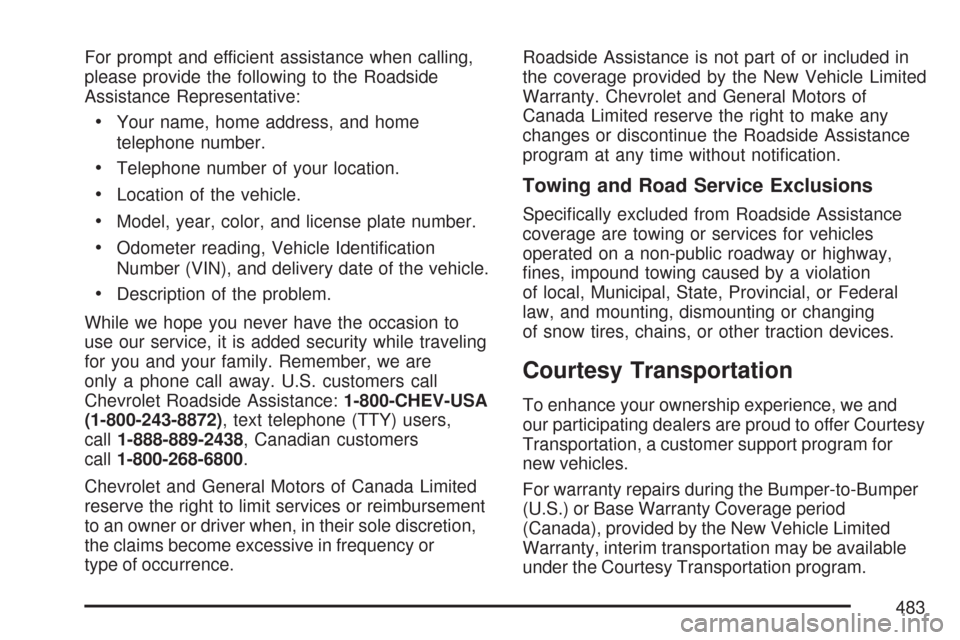
For prompt and efficient assistance when calling,
please provide the following to the Roadside
Assistance Representative:
Your name, home address, and home
telephone number.
Telephone number of your location.
Location of the vehicle.
Model, year, color, and license plate number.
Odometer reading, Vehicle Identi�cation
Number (VIN), and delivery date of the vehicle.
Description of the problem.
While we hope you never have the occasion to
use our service, it is added security while traveling
for you and your family. Remember, we are
only a phone call away. U.S. customers call
Chevrolet Roadside Assistance:1-800-CHEV-USA
(1-800-243-8872), text telephone (TTY) users,
call1-888-889-2438, Canadian customers
call1-800-268-6800.
Chevrolet and General Motors of Canada Limited
reserve the right to limit services or reimbursement
to an owner or driver when, in their sole discretion,
the claims become excessive in frequency or
type of occurrence.Roadside Assistance is not part of or included in
the coverage provided by the New Vehicle Limited
Warranty. Chevrolet and General Motors of
Canada Limited reserve the right to make any
changes or discontinue the Roadside Assistance
program at any time without noti�cation.
Towing and Road Service Exclusions
Speci�cally excluded from Roadside Assistance
coverage are towing or services for vehicles
operated on a non-public roadway or highway,
�nes, impound towing caused by a violation
of local, Municipal, State, Provincial, or Federal
law, and mounting, dismounting or changing
of snow tires, chains, or other traction devices.
Courtesy Transportation
To enhance your ownership experience, we and
our participating dealers are proud to offer Courtesy
Transportation, a customer support program for
new vehicles.
For warranty repairs during the Bumper-to-Bumper
(U.S.) or Base Warranty Coverage period
(Canada), provided by the New Vehicle Limited
Warranty, interim transportation may be available
under the Courtesy Transportation program.
483
Page 489 of 510
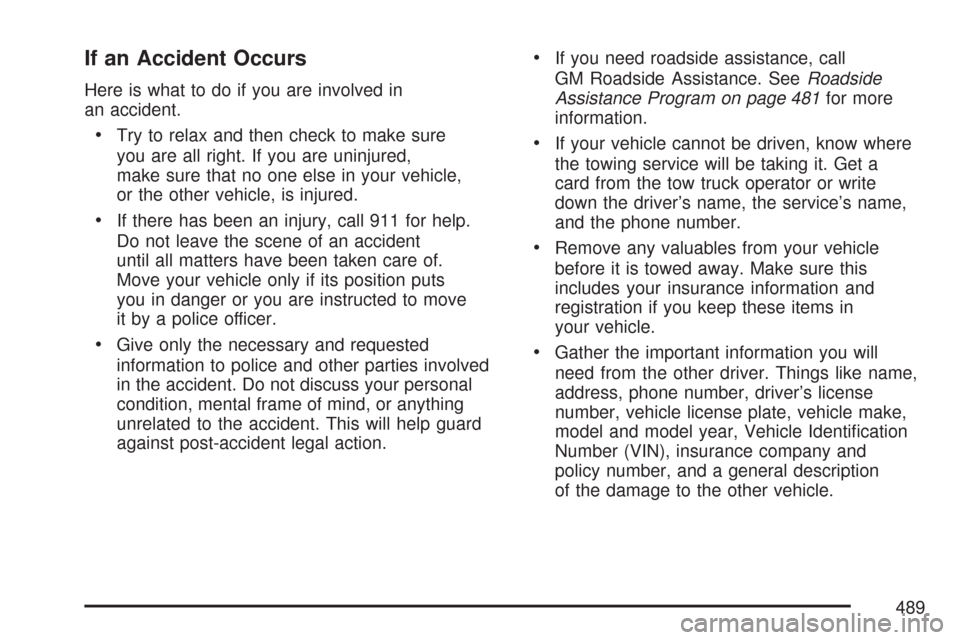
If an Accident Occurs
Here is what to do if you are involved in
an accident.
Try to relax and then check to make sure
you are all right. If you are uninjured,
make sure that no one else in your vehicle,
or the other vehicle, is injured.
If there has been an injury, call 911 for help.
Do not leave the scene of an accident
until all matters have been taken care of.
Move your vehicle only if its position puts
you in danger or you are instructed to move
it by a police officer.
Give only the necessary and requested
information to police and other parties involved
in the accident. Do not discuss your personal
condition, mental frame of mind, or anything
unrelated to the accident. This will help guard
against post-accident legal action.
If you need roadside assistance, call
GM Roadside Assistance. SeeRoadside
Assistance Program on page 481for more
information.
If your vehicle cannot be driven, know where
the towing service will be taking it. Get a
card from the tow truck operator or write
down the driver’s name, the service’s name,
and the phone number.
Remove any valuables from your vehicle
before it is towed away. Make sure this
includes your insurance information and
registration if you keep these items in
your vehicle.
Gather the important information you will
need from the other driver. Things like name,
address, phone number, driver’s license
number, vehicle license plate, vehicle make,
model and model year, Vehicle Identi�cation
Number (VIN), insurance company and
policy number, and a general description
of the damage to the other vehicle.
489
Page 490 of 510
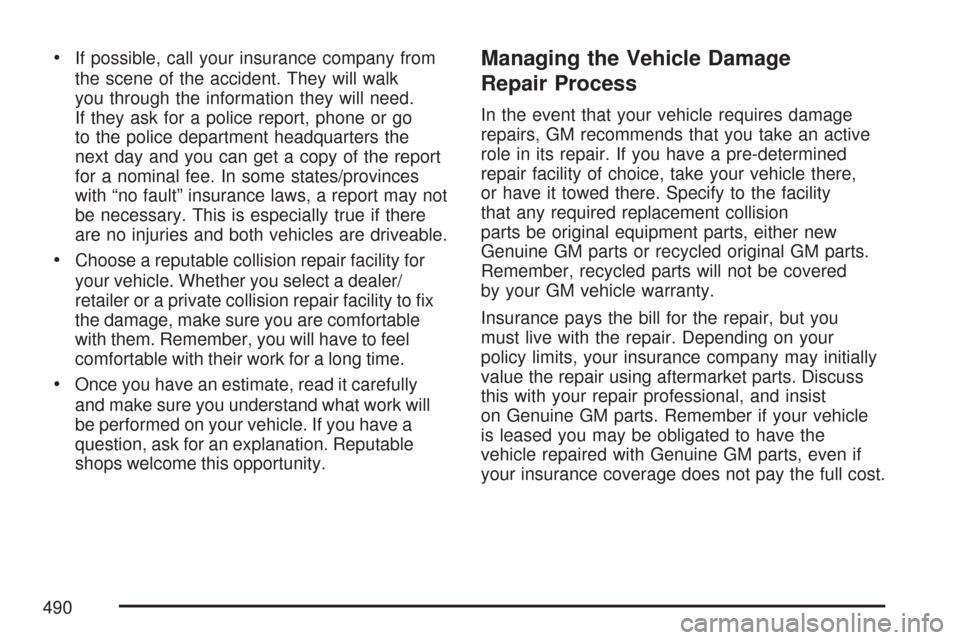
If possible, call your insurance company from
the scene of the accident. They will walk
you through the information they will need.
If they ask for a police report, phone or go
to the police department headquarters the
next day and you can get a copy of the report
for a nominal fee. In some states/provinces
with “no fault” insurance laws, a report may not
be necessary. This is especially true if there
are no injuries and both vehicles are driveable.
Choose a reputable collision repair facility for
your vehicle. Whether you select a dealer/
retailer or a private collision repair facility to �x
the damage, make sure you are comfortable
with them. Remember, you will have to feel
comfortable with their work for a long time.
Once you have an estimate, read it carefully
and make sure you understand what work will
be performed on your vehicle. If you have a
question, ask for an explanation. Reputable
shops welcome this opportunity.
Managing the Vehicle Damage
Repair Process
In the event that your vehicle requires damage
repairs, GM recommends that you take an active
role in its repair. If you have a pre-determined
repair facility of choice, take your vehicle there,
or have it towed there. Specify to the facility
that any required replacement collision
parts be original equipment parts, either new
Genuine GM parts or recycled original GM parts.
Remember, recycled parts will not be covered
by your GM vehicle warranty.
Insurance pays the bill for the repair, but you
must live with the repair. Depending on your
policy limits, your insurance company may initially
value the repair using aftermarket parts. Discuss
this with your repair professional, and insist
on Genuine GM parts. Remember if your vehicle
is leased you may be obligated to have the
vehicle repaired with Genuine GM parts, even if
your insurance coverage does not pay the full cost.
490
Page 506 of 510
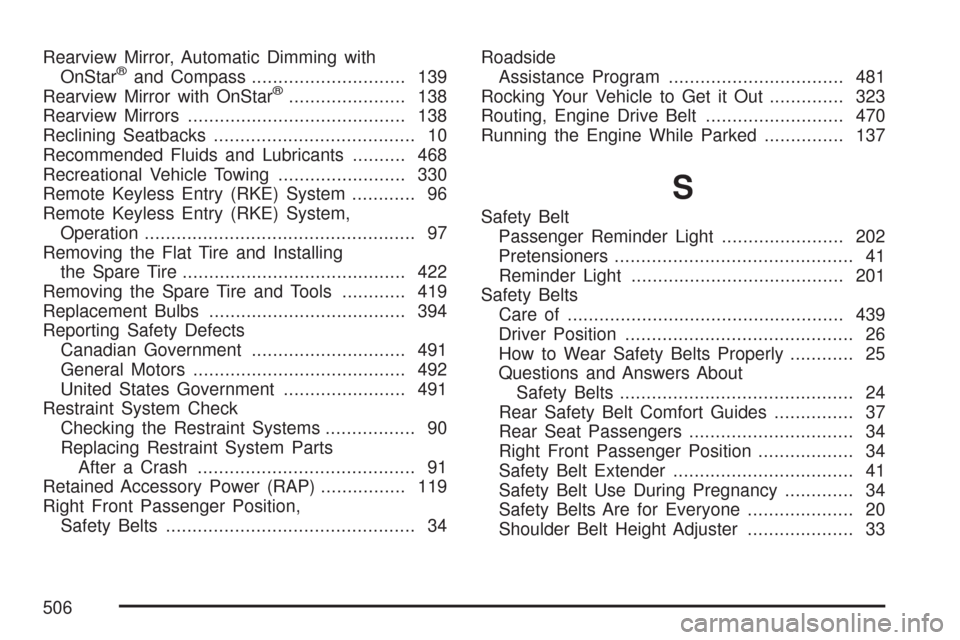
Rearview Mirror, Automatic Dimming with
OnStar®and Compass............................. 139
Rearview Mirror with OnStar®...................... 138
Rearview Mirrors......................................... 138
Reclining Seatbacks...................................... 10
Recommended Fluids and Lubricants.......... 468
Recreational Vehicle Towing........................ 330
Remote Keyless Entry (RKE) System............ 96
Remote Keyless Entry (RKE) System,
Operation................................................... 97
Removing the Flat Tire and Installing
the Spare Tire.......................................... 422
Removing the Spare Tire and Tools............ 419
Replacement Bulbs..................................... 394
Reporting Safety Defects
Canadian Government............................. 491
General Motors........................................ 492
United States Government....................... 491
Restraint System Check
Checking the Restraint Systems................. 90
Replacing Restraint System Parts
After a Crash......................................... 91
Retained Accessory Power (RAP)................ 119
Right Front Passenger Position,
Safety Belts............................................... 34Roadside
Assistance Program................................. 481
Rocking Your Vehicle to Get it Out.............. 323
Routing, Engine Drive Belt.......................... 470
Running the Engine While Parked............... 137
S
Safety Belt
Passenger Reminder Light....................... 202
Pretensioners............................................. 41
Reminder Light........................................ 201
Safety Belts
Care of.................................................... 439
Driver Position........................................... 26
How to Wear Safety Belts Properly............ 25
Questions and Answers About
Safety Belts............................................ 24
Rear Safety Belt Comfort Guides............... 37
Rear Seat Passengers............................... 34
Right Front Passenger Position.................. 34
Safety Belt Extender.................................. 41
Safety Belt Use During Pregnancy............. 34
Safety Belts Are for Everyone.................... 20
Shoulder Belt Height Adjuster.................... 33
506
Page 509 of 510
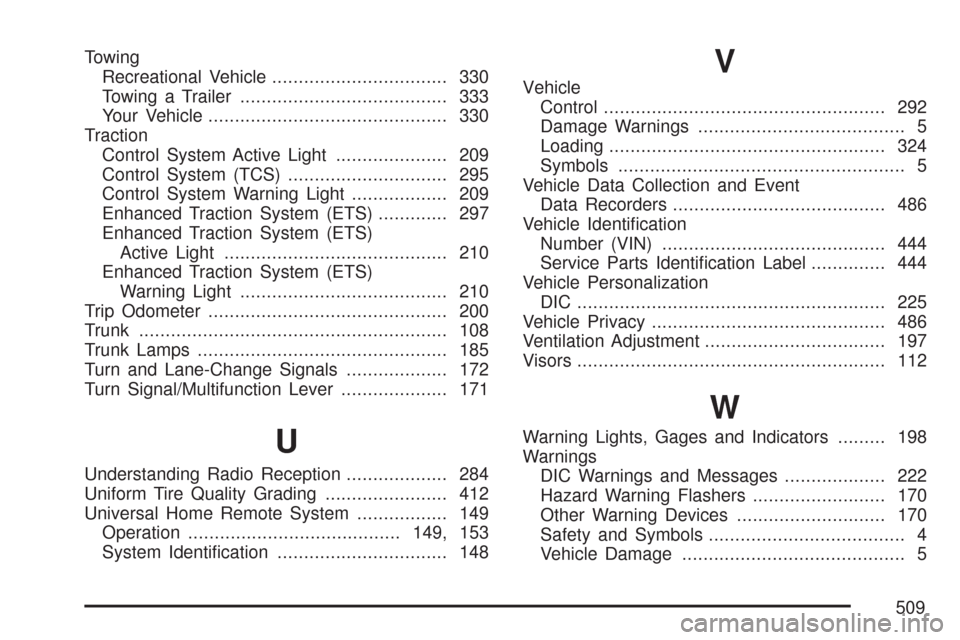
Towing
Recreational Vehicle................................. 330
Towing a Trailer....................................... 333
Your Vehicle............................................. 330
Traction
Control System Active Light..................... 209
Control System (TCS).............................. 295
Control System Warning Light.................. 209
Enhanced Traction System (ETS)............. 297
Enhanced Traction System (ETS)
Active Light.......................................... 210
Enhanced Traction System (ETS)
Warning Light....................................... 210
Trip Odometer............................................. 200
Trunk.......................................................... 108
Trunk Lamps............................................... 185
Turn and Lane-Change Signals................... 172
Turn Signal/Multifunction Lever.................... 171
U
Understanding Radio Reception................... 284
Uniform Tire Quality Grading....................... 412
Universal Home Remote System................. 149
Operation........................................149, 153
System Identi�cation................................ 148
V
Vehicle
Control..................................................... 292
Damage Warnings....................................... 5
Loading.................................................... 324
Symbols...................................................... 5
Vehicle Data Collection and Event
Data Recorders........................................ 486
Vehicle Identi�cation
Number (VIN).......................................... 444
Service Parts Identi�cation Label.............. 444
Vehicle Personalization
DIC .......................................................... 225
Vehicle Privacy............................................ 486
Ventilation Adjustment.................................. 197
Visors.......................................................... 112
W
Warning Lights, Gages and Indicators......... 198
Warnings
DIC Warnings and Messages................... 222
Hazard Warning Flashers......................... 170
Other Warning Devices............................ 170
Safety and Symbols..................................... 4
Vehicle Damage.......................................... 5
509